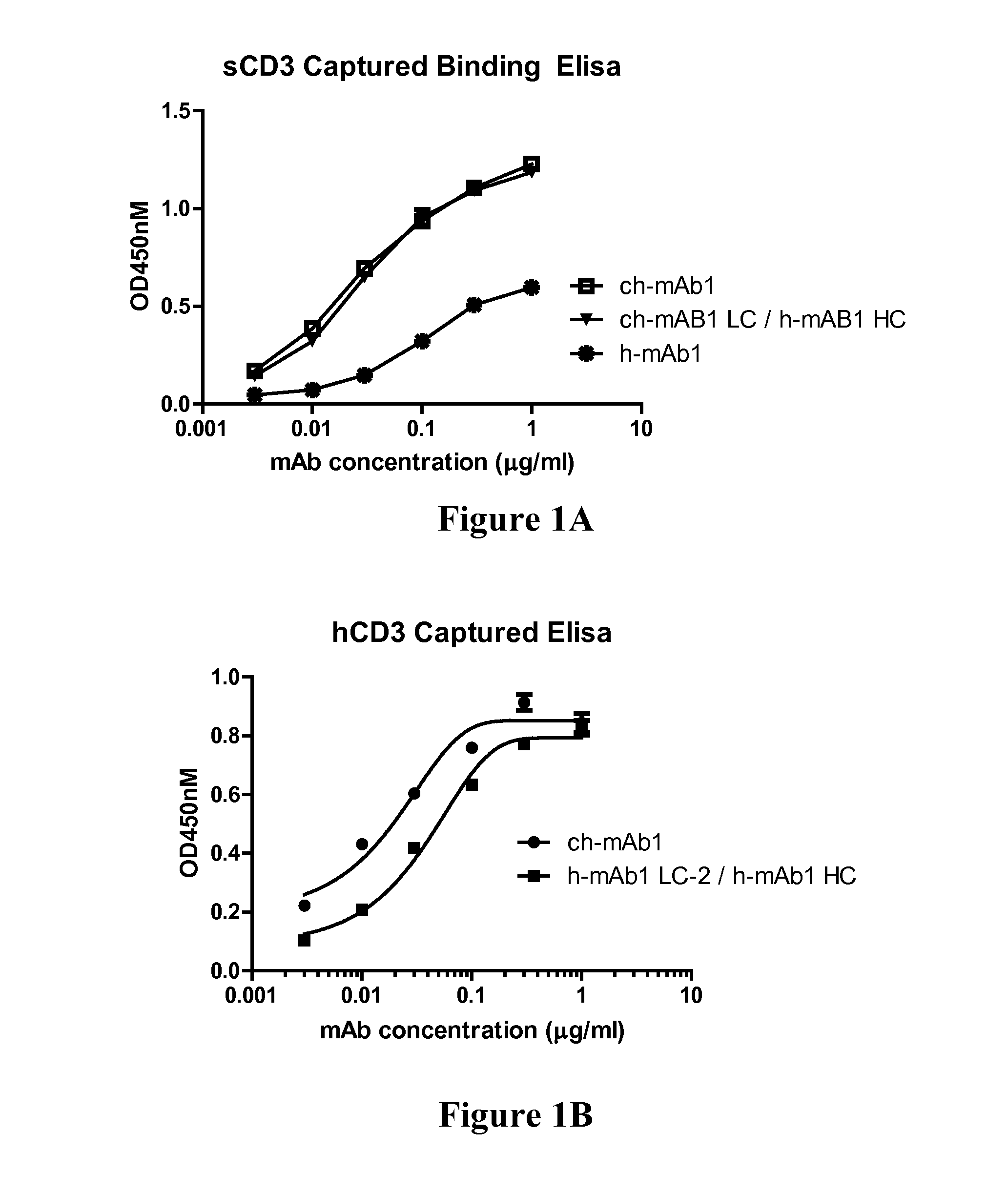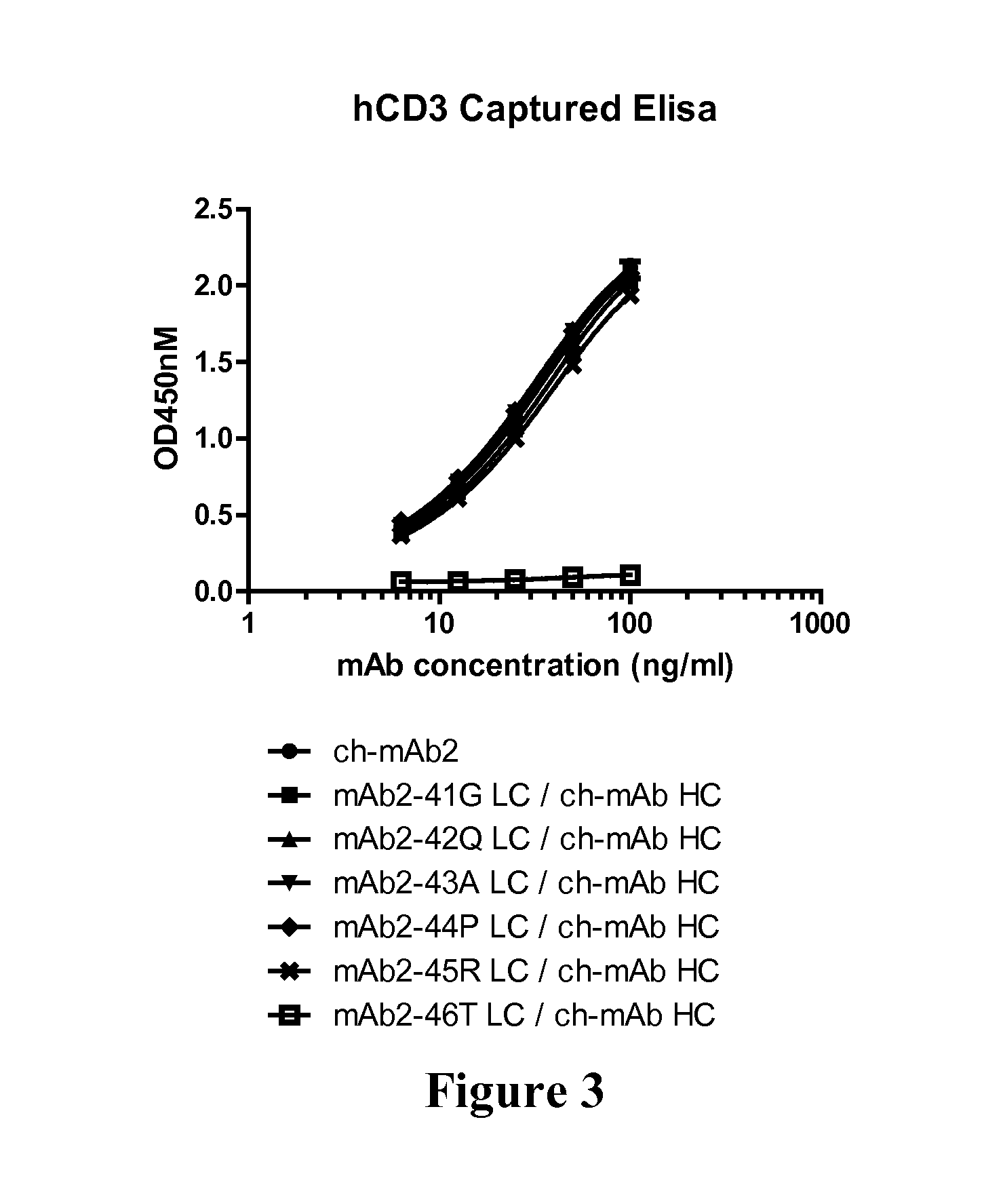CD3-binding molecules capable of binding to human and non-human CD3
a technology of cd3 and binding molecules, which is applied in the field of cd3-binding molecules capable of binding to human and non-human cd3, can solve the problems of insufficient signal generated by the interaction of t cells with antigen-presenting cells, inability to activate naive t cells, and insufficient anti-cd3 treatment specificity to avoid side effects,
- Summary
- Abstract
- Description
- Claims
- Application Information
AI Technical Summary
Benefits of technology
Problems solved by technology
Method used
Image
Examples
example 1
mAb1 Binds to Both Human and Cynomolgus Monkey CD3
[0253]In order to assess the ability of mAb1 to bind to human CD3, a capture ELISA was performed. Plates were coated with 1 μg / ml of soluble cynomolgus CD3 (“sCD3”) and incubated in the presence of various concentrations of a chimeric variant of mAb1 antibody (ch-mAb1) (containing the variable sequences of mAb1 and the constant regions of a human antibody), a humanized variant (h-mAb1) and an antibody composed of the light chain of the chimeric mAb1 antibody and the heavy chain of the humanized variant of mAb1. The results of this experiment are shown in FIG. 1A. The experiment shows the ability of mAb1 to bind to the CD3 of a non-human mammalian species. Additionally, the binding of the chimeric mAb1 antibody was compared to that of an antibody composed of the humanized variant mAb1 LC-2 and the heavy chain of mAb1. The results of this experiment are shown in FIG. 1B. The experiment shows the ability of mAb1 to bind to human CD3. FI...
example 2
Humanization of mAb1
[0254]Humanized derivatives of mAb1 were prepared. The amino acid sequences and encoding polynucleotide sequences of these humanized derivatives are shown below. The CDRs are shown in boldface and underlined.
[0255]Amino Acid Sequence of Humanized mAb1 Variable Light Chain Variant 1 (SEQ ID NO:10):
[0256]
DIQMTQSPSS LSASVGDRVT ITCSASSSVS YMNWYQQKPGKAPKRLIYDS SKLASGVPSR FSGSGSGTEF TLTISSLQPEDFATYYCQQW SRNPPTFGGG TKVEIK
[0257]Polynucleotide Sequence Encoding Humanized mAb1 Variable Light Chain Variant 1 (SEQ ID NO:11):
[0258]
gacatccaga tgacccagtc cccctccagc ctgtccgcctctgtgggcga cagagtgaca atcacctgtt ccgccagctcctccgtgtcc tacatgaact ggtatcagca gaagcccggcaaggccccca agcggctgat ctacgactcc tccaagctgg cctccggcgt gccctccaga ttctccggct ctggctccggcaccgagttc accctgacca tctccagcct gcagcccgaggacttcgcca cctactactg ccagcagtgg tcccggaacccccctacctt cggcggaggc accaaggtgg aaatcaag
[0259]Amino Acid Sequence of Humanized mAb1 Variable Light Chain Variant 2 (mAb1 LC-2) (SEQ ID NO:12):
[0260]
DV...
example 3
Humanization of mAb2
[0267]Humanized derivatives of mAb2 were prepared. The amino acid sequences and encoding polynucleotide sequences of these humanized derivatives are shown below. The CDRs are shown in boldface and underlined.
[0268]Amino Acid Sequence of Humanized mAb2 Variable Light Chain Variant 1 (h-mAb2 VL-1) (SEQ ID NO:16):
[0269]
QAVVTQEPSL TVSPGGTVTL TCRSSTGAVT TSNYANWFQQKPGQAPRTLI GGTNKRAPWT PARFSGSLLG GKAALTITGAQAEDEADYYC ALWYSNLWVF GGGTKLTVLG
[0270]Polynucleotide Sequence Encoding Humanized mAb2 Variable Light Chain Variant 1 (h-mAb2 VL-1) (SEQ ID NO:17):
[0271]
caggctgtgg tgactcagga gccttcactg accgtgtccccaggcggaac tgtgaccctg acatgcagat ccagcacaggcgcagtgacc acatctaact acgccaattg gttccagcagaagccaggac aggcaccaag gaccctgatc gggggtacaaacaaaagggc tccctggacc cctgcacggt tttctggaagtctgctgggc ggaaaggccg ctctgactat taccggggcacaggccgagg acgaagccga ttactattgt gctctgtggtatagcaatct gtgggtgttc gggggtggca caaaactgactgtgctggga
[0272]Amino Acid Sequence of Humanized mAb2 Variable Light Chain Va...
PUM
| Property | Measurement | Unit |
|---|---|---|
| concentration | aaaaa | aaaaa |
| concentrations | aaaaa | aaaaa |
| concentrations | aaaaa | aaaaa |
Abstract
Description
Claims
Application Information
 Login to View More
Login to View More - R&D
- Intellectual Property
- Life Sciences
- Materials
- Tech Scout
- Unparalleled Data Quality
- Higher Quality Content
- 60% Fewer Hallucinations
Browse by: Latest US Patents, China's latest patents, Technical Efficacy Thesaurus, Application Domain, Technology Topic, Popular Technical Reports.
© 2025 PatSnap. All rights reserved.Legal|Privacy policy|Modern Slavery Act Transparency Statement|Sitemap|About US| Contact US: help@patsnap.com



